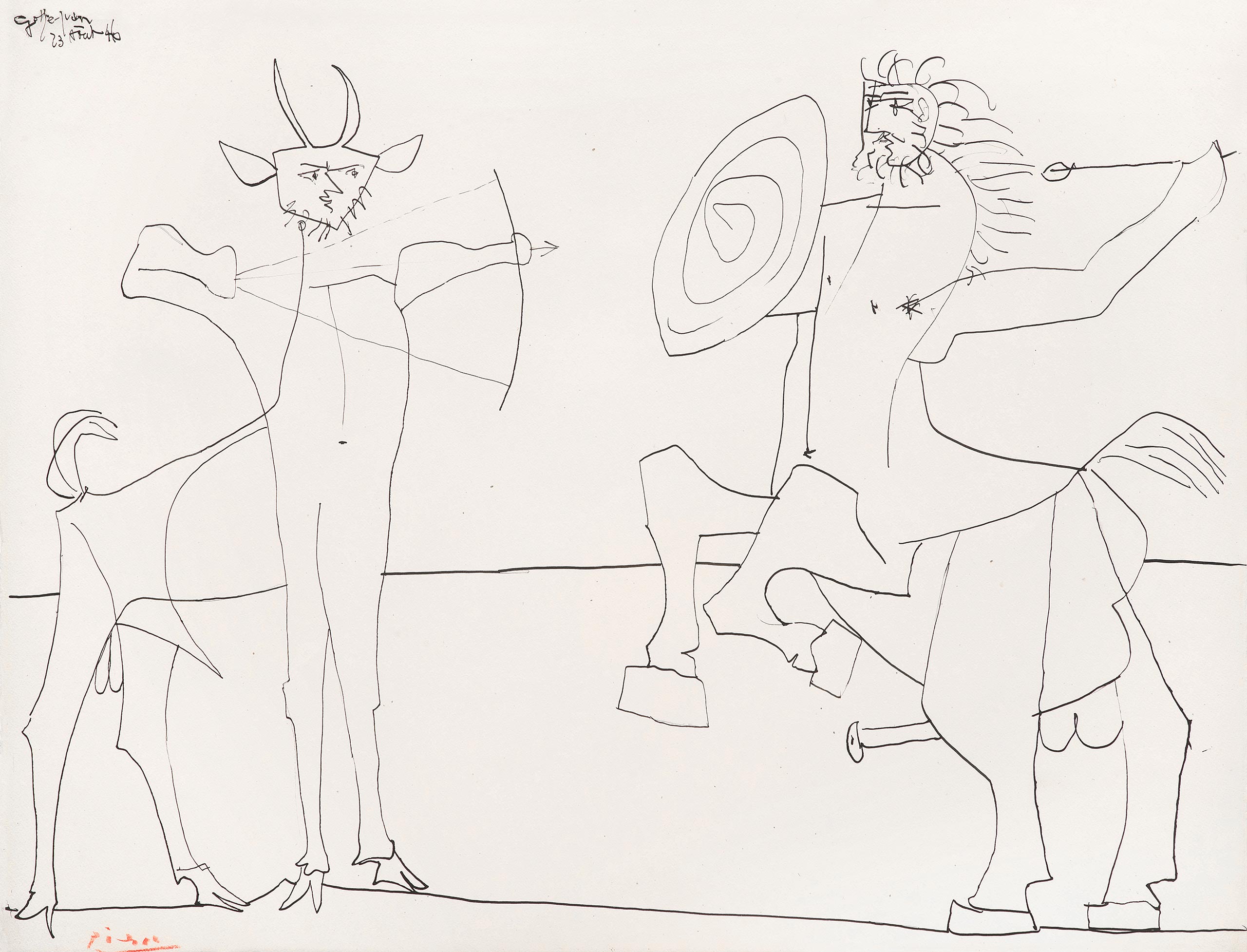
Picasso
Pablo
Malaga 1881 — Mougins 1973
Satyr and Centaur Battle
Signed Picasso in red pencil lower left; situated and dated
Golfe-Juan 23 Août 46 upper left.
502 x 657 mm (19 3/4 x 25 7/8 in.)
Provenance
Louise Leiris gallery, Paris; Private collection, Switzerland.
Bibliography
C. Zervos, Pablo Picasso. Œuvres de 1944 à 1946, vol. XIV,
Paris, 1986, n° 214, ill. p. 97; E. Mallen, Online Picasso project,
Comprehensive catalogue raisonné, 1946, OPP 46:510.
Executed on 23 August 1946 in Golfe-Juan, this drawing belongs to one of the most serene periods in Picasso’s life, when, from 1945 onwards, with peace restored, Picasso returned to the Mediterranean Sea, which had inspired him so much before the war. He stayed regularly in Golfe-Juan, on the Côte d’Azur or French Riviera. There he enjoyed a peaceful and happy relationship with Françoise Gilot, whom he had met in 1943. In early August 1946, they traveled to Golfe Juan and stayed in the home of the printer Louis Fort. Romual Dor de la Souchère, curator of the Antibes museum, offered Picasso a space for painting in the Grimaldi palace, where the museum was located but Picasso decided to decorate the museum itself. During the two next months, he worked extensively and produced 22 wall panels on Arcadian themes, known as the Antipolis series (Antipolis being the ancient Greek name for Antibes).
Elated by his love for Françoise Gilot and the proximity of the Mediterranean Sea, Picasso imbued his art with a new sense of serenity and humour. This period was also one of renewed fertility; François Gilot became pregnant while Picasso was working on the Antipolis series. The ancient Mediterranean legends once again fuelled his inspiration, and the monsters of the war years gave way to mythological creatures, nymphs, centaurs and satyrs, whose battles he imagined to be more playful than ferocious, always treated with his usual sense of line and composition.
Other drawings made on 21 and 22 August show his interest in the subject of centaurs, satyrs and fauns fighting. “It’s strange; in Paris I never draw fauns, centaurs or mythological heroes like these: it seems as though they only live here.” Constructed from geometric figures, his figures occupy the space of the sheet with humour. Triangles, circles and rectangles, sometimes drawn on solid colours, form these creatures whose faces are full of expression.
The composition of these large sheets is reminiscent of ancient reliefs on ancient sarcophagi and vases. The artist also treated these subjects in ceramics, revisiting the masterpieces of antiquity. It was an idealised vision of Greece that came to soothe him after the dark years of the World War II – the reference to an Arcadian world, classical and reassuring, although not without its own episodes of violence. But it is a mythological, distanced violence to which Picasso refers here, in an almost cathartic gesture. His conflicted relationship with Dora Maar has also been regarded as a source of inspiration for these battle scenes – she had a strength and personality that Picasso sometimes equated with war itself. A sheet of 22 August in particular depicts a centaur against a faun, whose ambiguous gender has sometimes led it to be compared to a female faun and therefore to Dora Maar.
For Michael FitzGerald however, François Gilot, who happened to be a talented rider, remains the real source of inspiration for this series: “Through the remainder of 1946, Picasso elaborated the imagined and real confrontations between himself and Françoise, but, increasingly, their personal relationship became absorbed into larger themes. In August he made a series of drawings that show a pitched battle between a faun and a centaur and end with the faun standing in mourning over his foe. Yet Picasso immediately proposed an alternative: the series resumes with the centaur’s resurrection, now as a beautiful woman, whose dance is joined by the joyous faun. The woman bears Françoise’s features, and Françoise’s birth sign of Sagittarius links her with the centaur as well”1.
A certificate of authenticity from Galerie Louise Leiris dated 2 April 2004 is provided with this work.
-
Michael FitzGerald, “A Triangle of Ambitions: Art, Politics, and Family during the Postwar Years with Françoise Gilot” in Picasso and Portraiture, Representation and Transformation, exh. cat., New York, The Museum of Modern Art, 1996, p. 424.

